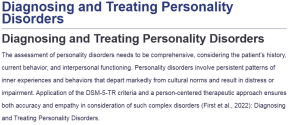Diagnosing and Treating Personality Disorders
The assessment of personality disorders needs to be comprehensive, considering the patient’s history, current behavior, and interpersonal functioning. Personality disorders involve persistent patterns of inner experiences and behaviors that depart markedly from cultural norms and result in distress or impairment. Application of the DSM-5-TR criteria and a person-centered therapeutic approach ensures both accuracy and empathy in consideration of such complex disorders (First et al., 2022): Diagnosing and Treating Personality Disorders.
Diagnosis
Mary’s presentation, with her emotional instability, self-injurious behavior, history of interpersonal difficulties, and chronic feelings of loneliness, suggests the diagnosis of borderline personality disorder (BPD). The DSM-5-TR characterizes BPD as a pervasive pattern of instability of interpersonal relationships and self-image and affects and marked impulsivity, starting by early adulthood (National Institute of Mental Health, 2024).
Differential Diagnoses
Mary’s symptoms establish a number of differential diagnoses: MDD, Generalized Anxiety Disorder (GAD), and PTSD. The history of depression and anxiety points out the major depressive disorder; at the same time, these conditions do not explain her interpersonal and emotional dysregulation. GAD is also diagnosed because of the symptoms of anxiety; however, it is not the main issue.
She might also be a candidate for PTSD in light of her parental divorce and severed maternal relationship that might have caused trauma. However, her symptoms more closely fit the diagnostic criteria for BPD.
Medication
The mainstay of treatment for personality disorders is not medication, but medication may be used to address comorbid conditions or specific symptoms. In Mary’s case, SSRIs such as sertraline may be indicated for the depressive and anxiety symptoms. Mood stabilizers like lamotrigine can be given for emotional dysregulation. However, caution should be taken, particularly in view of her history of self-harm and overdose (Pascual et al., 2023).
Treatment of Choice
Dialectical behavior therapy would be an excellent treatment of choice for Mary because it is an evidence-based intervention—especially for BPD. Skills training in DBT has four components: mindfulness, distress tolerance, emotional regulation, and interpersonal effectiveness. It teaches patients like Mary how to reduce self-destructive behavior and how to increase their quality of life.
The person-centered approach complements DBT in establishing a therapeutic alliance founded on empathy, unconditional positive regard, and genuineness. It empowers Mary to take an active role in her treatment and, by affording her the experience, validates her while encouraging growth. It respects her autonomy and fosters resilience in dealing with challenges.
Conclusion
Diagnosis and treatment of personality disorders require multidimensional approaches that bring together DSM-5-TR criteria with psychotherapeutic interventions like DBT and pharmacological support to manage symptoms. A person-centered framework ensures the patient feels understood and supported throughout the therapeutic journey.
References
First, M. B., Yousif, L. H., Clarke, D. E., Wang, P. S., Gogtay, N., & Appelbaum, P. S. (2022). DSM‐5‐TR: Overview of what’s new and what’s changed. World Psychiatry, 21(2), 218–219. https://doi.org/10.1002/wps.20989
National Institute of Mental Health. (2024, April). Borderline personality disorder. National Institute of Mental Health. https://www.nimh.nih.gov/health/topics/borderline-personality-disorder
Pascual, J. C., Arias, L., & Soler, J. (2023). Pharmacological management of borderline personality disorder and common comorbidities. CNS Drugs, 37(6), 489–497. https://doi.org/10.1007/s40263-023-01015-6
ORDER A PLAGIARISM-FREE PAPER HERE
We’ll write everything from scratch
Question 
Discussion Board—Diagnosing and treating personality disorders
Mary (28 years old) comes to see the PMHNP and says, “I need a new provider!” She has a history of panic, depression, and anxiety. She recently became upset with her boyfriend whom she thought was making negative statements about her, at which time, she went in the bedroom and began scratching her arms with a fork. She scratched hard enough to draw blood.
She is now sorry that she did this and thinks she may have over-reacted. She admits to a history of cutting herself. She took an overdose of sleeping pills when she was 14 and was subsequently hospitalized.

Diagnosing and Treating Personality Disorders
She has taken various SSRIs over the past 10 years, and she has a history of occasional binge drinking. Her parents divorced when she was 12 years of age and has since severed any relationship with her mother and only talks to her dad. She tells the PMHNP that she feels lonely and “alone”.
- The appropriate personality disorder diagnosis would be:
- What differential diagnoses should be considered?
- What medication, if any, should she be prescribed? Why or why not?
- What is the treatment of choice for this patient, and how does the person-centered approach to therapy align with this treatment?
